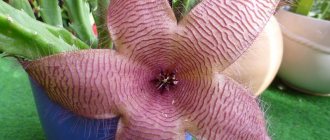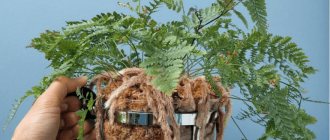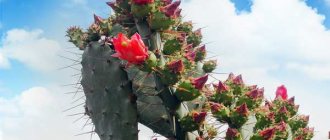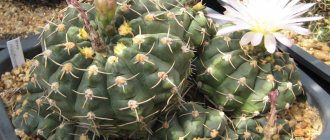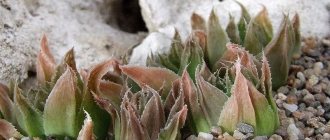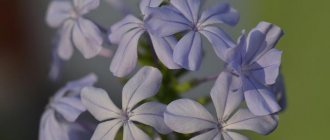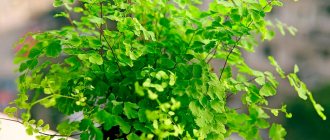Ceropegia is a perennial herbaceous plant belonging to the Lastovnevye family. The closest relatives of Ceropegia are Hoya and Stapelia. Translated from Greek, the name of the plant means “candelabra”, “candlestick”.
Ceropegia has a very original inflorescence. Flowers of the most bizarre shapes appear singly or in several pieces in the axils of the leaves: lanterns, necklaces, parachutes, fountains, antennas, tubes, they are raised. The petals are fused at the top and bottom and form a kind of trap for pollinating insects. When the insect gets there, floundering around trying to get out, it collects pollen, then the flower opens and releases the insect. In this way, pollination occurs in the natural environment.
Botanical description
Ceropegia voodoo care at home photo
The root system is tuberous. The leaves are mostly fleshy, thick, heart-shaped or lanceolate in shape. Roots and leaves are organs that store moisture. Some ceropegia have no leaves at all; such plants are not grown at home.
The shoots are long and flexible. In some species, nodules form on the stems, which over time produce roots and shoots. Ceropegia is grown as an ampelous, climbing, creeping plant.
Its natural habitat is the southern part of Africa, it can be found in the north of Australia, China, India, and the islands of the Canary archipelago.
Despite its unusual appearance and ease of care, ceropegia can rarely be found in home floriculture. Get to know this plant better, because the exotic ceropegia will be an excellent decoration for houses, apartments and other premises.
How to care for ceropegia at home
Ceropegia ampelous photo
Ceropegia are unpretentious in care; even beginners can cope with them.
There are some nuances:
- Ceropegia is a succulent plant. It is necessary to water moderately so as not to provoke rotting.
- Over time, the shoots stretch out, the leaves fall off, the plant loses its attractiveness, so it is necessary to replant every 5 years.
- Immediately provide a suitable support from which you can quite easily remove the plant when replanting.
- Plant several shoots in one container to make the bush more lush.
Choosing a location and lighting
Ceropegias love light and warmth. Lighting must be diffused, without direct sunlight. The best place would be windows facing east and west. When placed on the south side, provide shading. When placed on a north window, additional lighting with phytolamps will be required. Daylight hours should be about 12 hours.
Air temperature
In spring and summer, maintain the air temperature within 21-25 °C. In order for the plant to “rest”, keep the air temperature at 15 °C in autumn-winter. If the winter is warm, be sure to use artificial lighting.
Watering and air humidity
Balanced watering is important. Drying out or excess moisture can destroy the plant. Overdrying of the earthen clod leads to the falling of leaves, and flooding provokes rotting.
In summer, water generously as the top layer of soil dries, in autumn - moderately, and in winter (during cool wintering) it is enough to water once every 2 weeks. If the plant overwinters in a warm place with additional lighting, leave watering to “summer”.
There are no requirements for air humidity. For hygiene purposes, occasionally spray the plant and wipe off dust from the leaves with a damp sponge.
For watering and spraying, use soft, settled water at room temperature.
Feeding
In spring and summer, fertilizing is necessary every 2 weeks. Use fertilizers for succulent plants or orchids, diluted at half the concentration recommended by the manufacturer. The rest of the time, as well as young plants, do not need to be fed.
Trimming
Ceropegia do not need routine pruning. It is carried out to maintain decorativeness. Shorten shoots that are too long or broken off. To stimulate tillering, pinch the tips of the shoots.
Competent care for ceropegia
Ceropegia blooms all year round, subject to all agrotechnical requirements. It is necessary to create conditions so that the plant feels comfortable, like “at home” - in its homeland in tropical countries.
Temperature and lighting
Considering that ceropegia is grown as a hanging crop, it can be taken out onto the balcony in the summer. Decorate hanging baskets near the house or garden gazebo. Feels good at a temperature of 20-28°C without direct rays.
In winter, the permissible temperature range is 11-17°C, but not lower than 10°C. Loves cool air, but not dry air, otherwise the plant will stretch out. In the spring you need to cut off the tops and root. It is not demanding on humidity.
Watering
The plant requires moderate watering depending on the condition of the soil. Does not tolerate excess moisture and dryness. In summer, moisturize as it dries, preferably in the morning. In winter, it is enough to water the vine 1-2 times a month with settled water at room temperature.
Soil and fertilizer
Before planting, you should prepare the soil, consisting of:
- leaf and turf soil (5 hours each);
- humus (2 hours);
- river sand (1 hour);
- peat (1 tsp).
To protect the roots from rot, crushed charcoal and pine bark are added to the prepared soil. If it is not possible to prepare the composition yourself, buy ready-made soil for cacti and succulents in the store. The drainage layer makes up at least ¼ of the total volume of the finished mixture.
Choose a wide pot for planting, always with holes in the bottom to drain excess moisture. When growing, it is important to ensure that the soil with the plant is always loose and not crusty.
Fertilize the plant in the spring when transplanting young shoots and in the summer 1-2 times a month. Select fertilizer intended for cacti.
Ceropegia transplant
How to transplant ceropegia photo
Young plants require annual replanting. Older ones are replanted every few years. Roll over together with the earthen lump.
The container needs to be wide, not deep, with large drainage holes. The drainage layer should occupy ¼ of the volume.
The soil needs to be light, loose, water- and breathable. Suitable substrate for succulents or cacti. If possible, prepare a soil mixture: mix leaf soil, turf soil, humus, river sand in equal proportions, add a little charcoal, pine bark, and brick chips.
Diseases, pests, other difficulties
Ceropegia has fairly good immunity to diseases and pests.
Root rot is a major disease that occurs due to improper watering, low air temperatures, heavy soil or too large a pot. The shoots will become sluggish, the leaves will begin to turn yellow and fall off. Perform an emergency transplant. Remove the plant from the pot, trim off damaged roots, and treat with a fungicide. Replace the soil completely. Do not water immediately after transplanting. Then adjust the watering.
It is extremely rarely affected by pests. Spider mites, aphids, and mealybugs may appear. In this case, remove them mechanically: soak a cotton pad in soapy water and wipe the leaves, then treat with an insecticide.
- Due to lack of lighting, flowering may be absent, the shoots become thin and elongated, the leaves turn pale and curl.
- Exposure to direct sunlight leaves burns in the form of spots on the leaves.
- From lack of moisture, the stems and leaves dry out.
Reproduction of ceropegia by cuttings
Ceropegia cuttings photo
Cuttings are the most popular method.
- The cutting should contain 4-8 nodes; long cuttings are not divided, but pinned, sprinkled with earth.
- Root in early spring.
- The cut areas should be slightly dried and treated with a growth stimulator.
Rooted cuttings of Ceropegia photo
- Can be rooted in a sand-peat mixture or sand.
- Cover the top with film, place in a bright place, maintain the air temperature at about 24 ° C, ventilate regularly, and water with warm water.
Reproduction by nodules and dividing the bush
Reproduction of ceropegia by nodules photo
Wood's Ceropegia successfully reproduces by nodules formed on the stems. Cut off part of the shoot with a nodule and a couple of leaves, root it in the sand.
When transplanting, divide the rhizome. Remove the plant from the pot, divide it into parts with a sharp knife, each section should have a well-developed root system and several shoots. Treat the cutting areas with a fungicide, and plant the cuttings in separate containers.
Description of ceropegia
Ceropegia is a tropical perennial with fleshy stems that can be creeping, climbing or erect. They have small, thick leaves. Some species have almost no leaves at all, but such plants are not found in indoor floriculture. Most Ceropegia have the properties of succulents, and their foliage and stems contain clear sap that is considered poisonous. The rhizomes of ceropegia resemble tubers or have the shape of a spindle; plants also store moisture in them.
Axillary flowers with a tubular corolla, expanding at the base, are arranged singly or form inflorescences-umbrellas or racemes. The petals of each flower grow together at the top, giving it a very original shape. This structure promotes pollination of flowers - climbing into such a “candlestick”, the pollinating fly searches for a long time to find its way out, simultaneously collecting the pollen found in the flower. After some time, the hairs covering the exits weaken, releasing the fly to freedom. After flowering, elongated leaflet fruits are formed on the shoots. Seeds can be used for propagation.
Ceropegia woody | Secrets of care
Growing from seeds
Ceropegia seeds photo
Ceropegia seeds are difficult to find on sale and impossible to collect at home. If you managed to get them, sow them in the spring.
- Sow in light soil, plant the seeds one, two or three in one cup, so as not to dive.
- Cover the crops with film, maintain the air temperature within 20-25°C, ventilate and spray regularly.
Types of ceropegia with photos and names
The genus Ceropegia has more than 250 species.
Ceropegia suitable for home floriculture can be divided into 5 groups:
- Plants with rather thin, non-fleshy leaves.
- Tuberous varieties with both thin and fleshy leaves.
- Ceropegia with thin shoots.
- Liana-shaped ceropegia with very succulent stems, tiny leaves.
- The stems and leaves are succulent, the plant climbs.
Most often, Wood's ceropegia and Sanderson's ceropegia are grown indoors.
Wood's Ceropegia woodii cultivation and care
Ceropegia woodii flowering photo
Ceropegia voodoo is the most popular species. It has thin graceful stems, painted in a brownish-purple hue, the shoots hang from the pot in a dense network. Young leaves have a light green or lilac color, they are strung on shoots, like beads. Old leaves are thin, wide, and acquire a marble color.
In the summer, light potato-like nodules appear right on the shoots. They are used for plant propagation, and it does not matter which end of the tuber is placed in the soil - it will still take root and sprout.
Flowering lasts all summer and part of autumn. Tubular flowers appear in the axils of the leaves; they are pubescent inside. Moreover, flowers bloom on both old and new shoots.
Ceropegia Wooda is a succulent plant. It will bloom well even without high-quality watering and fertilizing; it reproduces very easily: it is difficult to find a less unpretentious plant.
Best grown in hanging pots. You can use stands of various shapes, which the flexible shoots will successfully entwin, but when the time comes for replanting, untangling the composition is quite problematic - damage to the plant is possible.
Sanderson's Ceropegia sandersonii
Ceropegia sandersonii flowering photo
It has long thin stems of dark green color. It looks very beautiful on a supporting structure, which the stems are upholstered with a snake. The leaves are located at a distance of about 20 cm from each other. They are fleshy, glossy, triangular in shape. Flowering occurs almost all year round. The greenish flowers consist of 5 petals fused into a tube. They are covered with white and greenish cilia. Flowers exude a pleasant, refined aroma.
This exotic plant is quite rare in flower shops; it is easier to purchase it at flower shows.
Let's look at other, less popular indoor ceropegies.
Ceropegia afrikana
Ceropegia afrikana photo
The stems are long and creeping. The leaves are small, oval in shape. Lantern flowers consist of a tubular bract and 5 petals and are green in color.
Ceropegia stapeliiformis
It has long thick stems dotted with growths-tubercles. The leaves are triangular in shape, small. The goblet-shaped flowers are burgundy-white in color.
Ceropegia elegans
Ceropegia elegans photo
Subtype of Sanderson's ceropegia. An ampelous plant with thin shoots. Leaves are heart-shaped. The flowers are five-petaled and white-green.
Ceropegia linearis
Ceropegia linearis
It has long narrow leaves, sparsely located on strong, elongated shoots. The flowers are lilac-violet, elongated.
Ceropegia aristolochio Ceropegia aristolochio >Ceropegia fantastica Ceropegia fantastica
Ceropegia fantastica photo
The flowers of this vine really look fantastic: on pink peduncles there are white flowers with a black and green pattern. Tiger spots combined with thin lines along the edges of the petals and rainbow spills inside.
Ceropegia variegata
Interesting variations of different species with variegated colors: the leaves are almost white, silver-green, with dark green veins, look very exotic.
Indoor plants, unusual in their appearance, have always enjoyed special attention from gardeners. After all, growing any representative of exotic flora in an apartment is sometimes very difficult. And all the more attractive are the views with which you don’t have to fuss and babysit a lot, like a small child. These include ceropegia. Caring for most of its varieties at home does not go beyond the usual maintenance of indoor succulents. But the unusual shape of the flowers, similar to candlesticks, elevates the plant to the rank of especially desirable for many domestic gardeners, and Wood's Ceropegia is doubly interesting, it also has incredibly colorful foliage.
Translated from ancient Greek, the name of the genus Ceropegia from the Kutrovaceae family sounds like “candelabra” and is associated with the structure and shape of the flower. The homeland of succulent vines is the tropical regions of Asia and Africa, but you can find this amazing flower in nature in Northern Australia, Madagascar, the Canary Islands, and New Guinea.
Indoor views
There are several indoor plant varieties; they can be found in the table.
| View | Characteristic |
| Voodoo (Voodoo) (ceropegia woodii) | One of the most common types, it takes root easily. The color of the leaves is marbled; when unopened, they look like purple and green beads. It is one of the ampelous flowers and resembles Galein's cross. |
| Ceropegia Sanderson | It has elongated, fleshy and smooth dark green leaves. Placed in pairs along the stem. The branches are quite fragile, so the plant definitely needs support. Blooms throughout the year. Five fused petals form a bud, which is shaped like a flashlight. |
| Stapelieform | This hybrid plant has a rather interesting appearance, and the presence of thick three-ridged stems with tendrils at the tops makes it possible to confuse ceropegia with some species of reptiles. The flowers are quite large, white with purple specks and mini in size. |
Strapeliform
Barclay
Sanderson
Voodoo or Voodoo
Another popular type of indoor plant is Ceropegia Linearis, its image can be seen in the photo.
Ceropegia linearis
Botanical portrait
Most ceropegia are herbaceous perennials with thick tuberous rhizomes that store moisture and erect or climbing succulent pagons, on which succulent oval or heart-shaped leaves are located opposite. The color of the crown is rich green, but Ceropegia variegata is also found with a pattern on the leaf blades of a cream, yellowish or marble hue. In some species, tiny bulblets form in the axils of the leaves, which, after contact with the soil, can grow and send out roots in conditions of high humidity.
Flowering stems also emerge from the axils of the leaves and bear single flowers at the apex or small umbellate inflorescences from tubular corollas widened at the base. The petals are often fused both at the bottom and at the top, forming a kind of trap for pollinating flies. Thanks to such a wonderful shape, the ceropegia flower has many popular names, for example, parachute, lantern flower, beach umbrella, snake vine, antenna, necklace, rosary plant and others. The fruits are spindle-shaped or cylindrical leaflets.
general description
Ceropegia is a perennial flowering herbaceous plant with a tuberous root system and creeping shoots. The leaves are oval, thickened, small in size, the arrangement of the plates is opposite. The shape can be lanceolate, ovoid or heart-shaped. Some species are characterized by miniature foliage or no foliage at all. Such flowers cannot be grown indoors.
Shoots of domestic ceropegia can reach a length of 1 meter. In some representatives of the genus, in particular, Wood's Ceropegia, nodules are observed in the nodes of the shoots, capable of growing and producing roots in conditions of high humidity.
Ceropenia is prized for its lush greenery
Flowers are formed in the leaf axils and can grow singly or be collected in small inflorescences that resemble umbrellas in appearance. The corolla has a cylindrical or tubular shape with a wide base. The shape of the flower is non-standard and in various species it resembles a lantern or candle. This explains the large number of popular names for the culture: lantern flower, antenna, snake vine, beach umbrella, necklace, parachute and others.
The petals of ceropegia flowers can grow together to form a trap for insects.
How to plant ceropegia correctly
The liana has an intensively developing root system, so the need to replant young plants arises every spring. More mature specimens are replanted every 2 or 3 years.
Choosing a flower container
When choosing a pot for a flower, take into account the size of the rhizome. The tubers should fill the inner space of the vessel so that the distance to the side walls remains at least 2 cm.
It is advisable to choose earthenware or ceramic, for such a dry-loving flower as Wood’s Ceropegia or another variety, it is important that the root system is not subject to waterlogging. In plastic containers, the earthen lump dries out more slowly. Be sure to use expanded clay drainage at the bottom of the pot.
Preparation of soil mixture
The substrate for growing ceropegia should be light, loose and breathable. In the assortment of flower shops you can choose the appropriate mixture for cacti or succulents from any manufacturer. It may require mixing a certain amount of sand to improve aeration.
To independently prepare the substrate, take equal volumes of humus soil, peat soil, leaf humus, add 15% coarse river sand and some medium-small pieces of charcoal.
During planting, the tubers are carefully placed on top of the drainage layer and a small layer of substrate, sprinkled with the remaining soil mixture on top so that the rhizome is completely covered with soil, although in some species it is possible to place the tubers partially above the level of the earthen clod.
Reproduction methods
Ceropegia is an easy plant to propagate. At home, cuttings take root well and seeds germinate well.
Rooting cuttings
They are cut in the spring, in March or April. For Wood's ceropegia, they try to select a stem fragment with an aerial nodule for rooting - the chances of getting a new plant in this case are almost one hundred percent. The cutting is buried in damp sand and the ambient temperature is maintained at 7 to 20 degrees Celsius.
How to propagate Ceropegia vuda
There are several ways to spread Ceropegia woodii: cuttings, tubers and seeds.
Cuttings
This procedure can be carried out in water or in a container with soil.
- To do this, prune a few hanging vines in the spring. Place the cuttings in a glass of water or in a container with prepared soil mixture, after removing the lower leaves.
- Change the water in the glass every week.
This will prevent water spoilage and ensure new oxygen enters the water. - After a few weeks, roots will begin to grow from the nodes of your cuttings and you can place them in soil. This takes 3-4 weeks. Ceropegia Woodii usually takes root quickly.
Another option is to place the cuttings in a pot, pushing them lightly into the soil.
- Lightly compact the planting area.
- Make sure there are no leaves underground, otherwise they will rot.
- After 3-4 weeks, the cuttings will begin to take root. As soon as new leaves appear, you can transplant the vine into a new pot.
How to propagate Ceropegia vuda with tubers
- Find areas with tubers on the shoots (they always form at the nodes of the stems).
- Place the tubers in the soil without cutting off the shoot. You can use the soil that is in the pot of your mother flower, or place the tubers in a soil mixture in another pot.
You don't need to trim the stem from your succulent. - After some time, roots will form on the tubers, and once they appear, you can cut the shoot from the main plant.
Propagation by seeds is a more complex process and is rarely used at home.
What are the maintenance requirements for ceropegia?
The succulent is very light-loving and develops well only with sufficient lighting. However, under the bright sun on the foliage, burns of the delicate tissue of the surface of the leaf blades easily occur. Indoors, they try to place the ceropegia so that it receives a lot of light, and at the same time does not suffer from its intensity.
The optimal thermal regime for the vine is 12-24 degrees, and winter maintenance should not only be cool - up to 15 degrees, but also dry. The critical temperature for a succulent is 10 degrees above zero, it is advisable not to allow it to be lower, otherwise the foliage will fall off and the tubers will die.
Features of care
Ceropegia reacts very painfully to stagnant air in the room, so along with traditional care measures, you should often ventilate the room in which the succulent grows.
Watering and air humidity
The environment for growing ceropegia requires a dry one, so additional means of increasing air humidity are not only not needed, but, on the contrary, can cause harm to a succulent vulnerable to rot.
Careless abundant watering can quickly destroy a flower, so the grower should be extremely careful about the watering regime of ceropegia. In summer, ceropegia are watered once a week, when the earthen ball dries out. In autumn, moisture is reduced to once a decade, and in winter it is watered twice a month, or even less often, depending on the temperature in the room.
Feeding
During the active growing season, the vine is fed with complex fertilizers for succulents and cacti once every 2 weeks. They try to avoid formulations with a large percentage of the nitrogen component. During winter dormancy, feeding is stopped.
Pruning, need for support
Ceropegia is grown as an ampelous plant, placed on a raised stand or hanging in a flower pot. If the plant is placed on a windowsill or table next to a window, it must be provided with a support, otherwise some cultivated species cling to the curtain with their tendrils. It will not be possible to tear them off without damaging the fragile pagon.
In the spring, the pagons can be shortened if they grew too long in the previous season. Cut fragments of stems are used for propagation, cutting into several cuttings.
They try to trim off faded inflorescences in a timely manner, stimulating the formation of new buds. By creating favorable care conditions for ceropegia, you can achieve frequent flowering.
Growing conditions for indoor ceropegia
Ceropegia prefer to grow in bright light. They are comfortable on southern and partially southern windows, they love soft sunlight. Even summer midday hours can be dangerous for them only if there are hot temperatures and lack of access to fresh air.
Lack of lighting affects the shape of the shoots and the size of the leaves. For almost continuous flowering from autumn, the plant needs to be supplemented with light or moved towards the light.
Ceropegias love nighttime drops in temperature (but not sharp jumps from “average” conditions) and they often do well in the same place as popular indoor orchids. In rooms they will prefer coolness, a temperature of 20 to 23 degrees, rather than heat. But with frequent ventilation they can withstand any temperature. A cool, bright room with temperatures ranging from 12 to 16 degrees Celsius (minimum 10 degrees) is considered ideal for wintering ceropegia.
In summer, the plant can be placed outdoors. Regular ventilation is a mandatory measure when growing ceropegia.
Creeping Ceropegia, or Sanderson's (Ceropegia sandersonii). © suculentasbrasil
Diseases and pests of ceropegia
The main problem in growing the plant is the rotting of tubers and pagons in conditions of high humidity. Consequently, waterlogging of the earthen coma should not be allowed. If the first signs of rot appear, the affected areas must be removed immediately. Healthy fragments of stems are rooted so as not to be left without an amazing flower.
The foliage very soon signals about excessive watering - it becomes pale and crumbles. This phenomenon usually occurs in winter. Unnaturally elongated branches and small leaves indicate insufficient lighting or a lack of nutrients. In cool conditions and slight overwatering, the foliage turns yellow.
Among the pests on ceropegia are mealybugs, aphids and spider mites. For small lesions, sometimes washing the plant with warm soapy water helps. Large colonies of insects are destroyed with systemic insecticides, and acaricidal drugs approved for indoor use are used against ticks.
Possible problems in growing
Despite all its unpretentiousness, this exotic also has its problems. Fortunately, they are not difficult to solve.
Pests
Pests generally avoid this plant because it contains poisonous sap. Occasionally, mealybugs, spider mites or aphids may appear on flowers. To get rid of uninvited guests, just wash the flower with soapy water. This should be done very carefully so that soapy water does not get on the ground.
Important! This plant is poisonous, so you should consider placing it in your home in such a way as to prevent contact with children or pets.
Other problems
There are other difficulties in growing:
- With a severe lack of moisture or dry air, the leaves of the plant may begin to dry out and crumble.
- Due to insufficient lighting, the leaves become smaller, curl and turn pale.
- If you frequently overwater a plant, it will begin to rot and may even die.
- Reddening of the leaves may occur as a result of sunburn.
It’s easy to understand what the problem is - the plant itself will tell you the answer. All that remains is to improve his care a little.
Types of Ceropegia, popular in indoor cultivation
According to the Internet project The Plant List, the genus Ceropegia includes about 217 species of herbaceous perennials and climbing plants.
Wood's Ceropegia (C. woodii) is the most popular species in cultivation with a large tuberous root, from which several thin, almost thread-like, drooping stems grow. The pagons reach approximately 2 m in length, covered with fleshy leaves in the shape of a kidney or heart.
On the upper side, the color of the leaf blades is light green, with a silvery pattern, and on the bottom - with a slight pinkish tint. The corollas, similar to small candles, are painted white, light lilac or violet. They appear continuously throughout almost the entire year.
Ceropegia graceful (C. elegans) is a perennial with spectacular creeping runners, evenly covered with elongated, short-pointed at the apex, ciliated leaves. Tubular corollas form a few-flowered umbellate inflorescence. The tops of the white petals with a purple or purple-cherry pattern are also decorated with delicate eyelashes.
Sanderson's Ceropegia (C. sandersonii) is a herbaceous vine with creeping shoots and thick ovoid leaves. The inflorescences are few in number, consisting of flowers with awl-shaped petals forming a light green-cream corolla, reminiscent of a parachute canopy with a ciliated edge.
Ceropegia Fusca (C. fusca) is an exotic species native to the Canary Islands with thin grayish-green erect pagons covered with a waxy layer. They remain leafless for most of the season.
African Ceropegia (C. africana) is a herbaceous liana with fleshy burgundy stems and very picturesque heart-shaped leaves, in which emerald convex spots appear on a silver background, and a purple-green border stretches along the edge of the plate. The flowers are pink-purple, tubular, widened at the base and fused at the apex, decorated with dark cilia.
Ceropegia stapeliiformis (C. stapeliiformis) is a perennial with creeping stems, round in cross-section closer to the base and triangular near the apex. The leaves are small, with small stipules. The inflorescences consist of 2-3 tubular corollas, opening with long sharp petals of white and dark purple color.
Features of ceropegia
Ceropegia is a herbaceous perennial plant that can be climbing or erect. The rhizome has a tuberous or thickened spindle-shaped shape, and there is an accumulation of moisture in reserve. This plant has creeping and fleshy shoots. Opposite thickened small leaf plates have a linear, ovoid or lanceolate shape. Most species have succulent shoots and leaf blades. As a rule, the juice of such a plant is clear and not milky. Umbrella-shaped or racemose inflorescences consist of large five-membered axillary flowers, their corolla is tubular at the base, expanded. The flowers have stamens fused into a tube. The fruit is a leaflet of a spindle-shaped, cylindrical or linear shape.
Botanical description of the plant
The natural habitat of Wood's Ceropegia is extensive and includes:
- southern Africa;
- northern Australia;
- India;
- China;
- Canary Islands.
Ceropegia Wooda is a liana-shaped perennial succulent that belongs to the Lastovnevye family. The rhizome is tuberous. Thin, heart-shaped leaf plates are located opposite on long, thin shoots. The outer surface of the leaves has a marbled silver pattern, the lower surface is purple.
Small tuberous growths form in the axils of old leaf blades, which play a role in accumulating and retaining moisture. The plant can go without water for a long time, even in drought, thanks to these growths and tuberous thickenings of the roots. The stems look like threads dotted with leaf hearts. They are intertwined and colored purple. Even with home cultivation, the stems can reach a length of 2.5–3 m.
Classification and description of the species Ceropegia Wood
Plant classification
Scientific name: Ceropegia woodii Synonyms: Ceropegia linearis, Ceropegia linearis subs. woodii Common name: Ceropegia Wooda or Voodoo Family: Apocynaceae Subfamily: Asclepiadoideae Genus: Ceropegia
Ceropegia Vooda (Voodoo) is an evergreen caudex creeping vine native to South Africa (Swaziland and Zimbabwe). This flower was first discovered in 1881 by John Medley Wood (curator of the Durban Botanic Gardens) on the slopes of Mount Groenberg. The scientific name for the species Ceropegia woodii was given in honor of its discoverer. This flower is sometimes considered a subspecies of the related Ceropegia linearis. Because of its appearance, in Western countries the succulent is also called “String of Hearts”, “Chain of Hearts”, “Collar of Hearts”, “Hearts on a String”, “Snake Vine”, etc.
Ceropegia Wooda will naturally grow in regions of southern Africa, in areas with well-drained soil, low rainfall and little sun.
Visually, this flower looks like an evergreen creeping vine that grows up to 2-5 cm in height, and its hanging stems reach up to 1.5 m in length (in nature up to 4 m). The stem is quite thin and soft with beautiful heart-shaped leaves, up to 2 cm wide and long. The leaves are marbled with shades of silver and green on the upper part and green to purple on the lower surface. With age, a woody caudex develops at the base of Ceropegia vuda, which can increase in size. Tubers often form on the roots and sometimes on the stems (on the shoots they form at the nodes).
The flowers are generally similar to other Ceropegia species - waxy and narrow, with a convexity at the base, visually resembling inverted vases up to 3 cm long, grayish-white or pale purple (often brown). Ceropegia vuda's flowering season begins in late summer and into fall (but flowers can appear until mid-winter under ideal succulent growing conditions).
Optimal conditions for growth
Hardy Wood's ceropegia are not at all whimsical in terms of microclimate.
Lighting
In the presence of high-quality illumination, flowering of Ceropegia Wood can continue almost all year round. She is not afraid of short-term contact with direct sunlight. It is better to place plants on the east or west side of the room.
Ventilation
In summer, it is better to move plants to the balcony. In winter, ventilation must be carried out, but drafts must be avoided.
Temperature
Ceropegia is not at all demanding on temperature conditions and tolerates temperature changes from +10°C to +27°C. But to achieve year-round flowering, it is better to maintain a constant temperature within +20. +23°С.
Air humidity
Air humidity can be any. Additional moistening of the space around the plant and spraying are not required even during the driest periods.
Briefly about cultivation
- Flowering: in good conditions - almost all year round, but the flowers of the plant are not decorative.
- Lighting: bright sunlight, light shading is required in the afternoon in summer.
- Temperature: during the active growing season - 20-25 ºC, in the fall the temperature is gradually lowered, and in winter the succulent is kept at 14-16 ºC. The lower temperature limit is 11 ºC.
- Watering: from spring to autumn - moderate, as soon as the top layer of the substrate dries, and in winter - three days after the top layer dries.
- Air humidity: does not matter.
- Feeding: young ceropegia are not fed, but a solution of mineral fertilizer for succulents or orchids is added to the substrate of adult plants from spring to autumn once every 3 weeks in half the dosage specified in the instructions. Fertilizers are not needed in autumn and winter.
- Dormant period: in winter, but not clearly expressed.
- Transplantation: young plants - every spring, adults - as needed.
- Reproduction: seeds, cuttings and division of rhizomes.
- Diseases: fungal rot.
- Pests: mealybugs, spider mites and aphids.
Read more about growing ceropegia below.
Home care
It is difficult to find a more grateful plant than Ceropegia. Even with minimal care, it blooms profusely until autumn.
Watering
You will not need to water this plant often. There is no specific watering schedule - you need to focus on soil moisture. Water is added when the top layer of soil dries 1 cm deep. In summer, watering is carried out approximately once a week, but it can be more often if the air temperature rises above +27°C. In winter, watering should be reduced to a minimum - 1-2 times a month.
It is best to water from the top. Water is poured along the edge of the pot, being careful not to get it on the shoots and leaves. Any liquid that has drained into the pan must be removed immediately. Do not allow the soil to become waterlogged, otherwise the roots may rot. Water for irrigation should be at room temperature. Settled tap water is suitable. It is better not to use boiled water - it contains traces of salts and scale, which can damage the plant.
Top dressing
Fertilizers are applied once a month during the active growing season; in winter they are excluded. As a top dressing, you can use complex preparations intended for cacti, succulents and orchids. The fertilizers “Stimovit for cacti and succulents” and “Stimovit for orchids” have proven themselves well. They are diluted according to the instructions and applied at the root.
Trimming
Ceropegia does not require mandatory pruning. It is carried out if there is a need to shorten shoots that are too elongated, or when a plant needs to be propagated. Shoots play an important role in feeding the plant and storing moisture, so excessive pruning can lead to drying out.
Transfer
Transplantation is carried out in March - April annually until the plant reaches three years of age. Subsequently, transplantation is carried out every 2 years.
Transplantation is carried out using the transshipment method. Pots are selected small in height and wide. The new container should be 1 finger larger in diameter and height than the previous one. The main requirement is a large number of drainage holes. It is better to mix the soil yourself.
To do this, connect:
- 5 parts leaf-turf soil;
- 2 parts of plant humus;
- 1 part peat;
- 1 part sand.
To increase the looseness of the soil, add 20% perlite and 10% sphagnum moss to the resulting composition. The earth is disinfected with a solution of wood ash: for this, add 1 tbsp to 2 liters of water. l. ashes. The liquid is mixed and brought to a boil, poured immediately hot into the soil and stirred thoroughly. The pots are disinfected using a manganese solution: add 2 g of the substance to 1 liter of water. The day before transplantation, watering is carried out, but not too much.
Expanded clay mixed with foam shavings or perlite is placed in new containers. Drainage should occupy 1/4 of the pot. Then lay 1 cm of soil. The plant is removed from the old container and the roots are examined: if everything is fine, it is moved to a new container. The voids are filled with soil, the surface of the soil around the stems is slightly compacted.
The transplanted plant is left for 5 days in a place where there is high-quality protection from direct sunlight. After this time, you can move the ceropegia to a permanent place and, if necessary, lightly moisten the soil surface.
Features of cultivation and care
Lighting and temperature
In nature, all species grow in the same temperature and climatic conditions, which are easy to create at home. There are several general rules that must be followed to make the plant feel comfortable.
- All succulent plants (including ceropegia) are easily susceptible to root rot. Do not forget that the root of the vine is a tuber that accumulates water. Therefore, watering should be as needed. This is easy to determine by touch. Watering should only be done when the soil is completely dry.
- Once every five to six years, the vine must be renewed: old stems without leaves and flowers must be removed. Often young shoots become very tangled, and then it is very difficult to remove the old ones. It is better to take care of this in advance and direct the young shoots to the right place.
- To create green lushness of some types of these vines, several plants can be planted in one pot at the same time. Also, when you create a mini-garden of exotic plants, make sure that they all have similar growing conditions.
All Ceropegia love direct sunlight. The longer the period of such illumination, the better. And in winter, with short daylight hours, it is necessary to illuminate the plants with special lamps.
With a lack of light, the plant becomes impoverished, stretches out and stops blooming. In spring and summer, you can take the vines out onto the glassed-in loggia.
The temperature regime is very suitable for our apartments - since the plants tolerate changes in day and night temperatures well in spring and summer. In winter, to give them a period of rest, you need to reduce the temperature to 16 -18 degrees. Such a place can be found on an insulated balcony or loggia.
Air humidity
Plants are not adapted to humid air; they are better suited to the dry air of our apartments. But if you overdry the earthen substrate for a long time, the plant will wither and may even die.
Also read: Cotyledon - introduction to the types and care of the plant
The soil
The soil is normal for succulents. It should be loose and include inorganic particles. This earthen mixture is easy to make yourself. To do this you will need in equal quantities:
- Humus. It is better to take it from the garden plot. If you don't have your own, ask your neighbors. Look through it for grubs, worms and large undecayed remains.
- Leaf soil. It is better to collect it under deciduous trees. Also check for unnecessary impurities.
- Sod land. City lawn soil is not suitable; land taken outside the city limits, away from roads, is needed.
- Coarse river sand, washed and disinfected, using any method known to you.
- Finely crushed charcoal.
Everything needs to be mixed thoroughly. You can add some crumbs from red bricks and pieces of pine bark. If making your own soil mixture is difficult for you, you can buy a ready-made soil mixture for cacti and succulents in a specialized store. She'll do too.
Choosing a pot and replanting
The choice of flower pot is also important. It should have wide holes at the bottom to drain excess water. Moreover, the height of the drainage should be at least one quarter of the total volume! If these rules are not followed, the plant is at risk of rotting of the rhizome. Otherwise, you will enjoy original greenery and amazing flowers.
A plant transplanted into fresh substrate does not need feeding, but after a year it is worth feeding it. This is done once every two weeks in spring and summer. During the dormant period, there is no need to fertilize the plant. As a balanced fertilizer, a 1:1 diluted fertilizer for succulets or orchids is quite suitable.
Annual replanting is necessary only for young plants. Older flowers are replanted once every two to three years. It is better to transfer from a smaller pot to a larger one, carefully adding fresh soil.
Trimming
Ceropegia does not need mandatory pruning. But for decorative purposes it is necessary to pinch out long shoots; old shoots left without leaves and flowers spoil the entire appearance. Such shoots can be cut out completely. Pinching promotes branching of stems. Young shoots will decorate the upper part of the plant.
Reproduction methods
Wood's ceropegia can be propagated at home in several ways:
Propagation by seeds
Seed material is planted in the spring. The substrate for planting should be light and loose. At this stage, you can use a mixture of sand and peat, adding a little leaf humus - about 20% of the total volume of the mixture. The mixture can be disinfected in the oven at a temperature of +100°C. After disinfection, the soil must be moistened; its structure should be quite loose, but not waterlogged.
Drainage is laid at the bottom of the common container, then soil is placed. The seeds are laid directly on the surface of the soil and sprinkled with sand. The height of the sand layer is about 0.5 cm. Then the plantings are sprayed with a spray bottle and covered with glass. Germination is carried out at a temperature of +20. +25°С. Every day of planting you need to ventilate by removing the glass for 20 minutes. If necessary, the soil is additionally moistened with a spray bottle.
Seed germination takes an average of 20–25 days. After the sprouts appear, the glass must be removed and the container moved to a well-lit place, but not in direct sunlight. Subsequent care is standard. When the sprouts reach a length of 7–10 cm, you need to transplant them into different containers: 2-3 copies are planted in each container.
Cuttings
Cuttings are prepared in early April. High-quality planting material should have 3 nodes. The lower leaves must be removed, and the cuttings themselves must be withered for 3 hours. The lower part of the cuttings is dusted with wood ash. Root the sprouts in damp sand with minimal addition of peat. Humidification is carried out using “Epin”: add 2-3 drops of the drug to 1 liter of water.
This move promotes faster root growth and increases the adaptive abilities of plants. It takes an average of 1.5 months to root cuttings. In mid-summer you can transplant into different containers.
Reproduction by division
This method is used at the time of plant transplantation. When removing the plant, the root system is divided into 2 equal parts and the resulting bushes are planted in separate containers. To speed up adaptation, add “Epin” or “Zircon” to the water for irrigation - 2-3 drops of these drugs.
Reproduction
Ceropegia can be propagated in several ways. Those plants that form aerial nodules are best propagated by cuttings containing them. Can be propagated:
- Ordinary cuttings.
- Seeds.
- By dividing the rhizome.
Cuttings intended for propagation must be dried for two to three days. They should contain from three to five internodes. Then the prepared cuttings need to be pinned to a substrate of peat and sand (sold in flower shops) or to clean, damp sand without internodes mixing with the soil. Be sure to cover with film to create the necessary humidity, but do not forget to ventilate. Place the pot with the shoots in a sunny place.
Also read: Monilaria - bunny ears
Seeds of various types of Ceropegia can be bought in flower shops, but rare species can be found in online stores. The seeds are evenly distributed onto the prepared substrate and lightly sprinkled with soil. Cover with film and place in a bright place. Shoots appear in about two weeks, sometimes a little later. The film is removed for ventilation, and after two sheets appear it can be removed completely. Plant the grown seedlings into separate pots.
You need to divide the rhizome when replanting an old plant. It is necessary to divide the rhizome in such a way that each part contains growth buds and a significant part of the tubers. Ceropegia tolerates such reproduction most painlessly.
Possible difficulties during cultivation
When cultivated at home, ceropegia rarely gets sick.
If the substrate is over-moistened, one of two problems may occur:
- root rot - in such cases it is rarely possible to completely save the plant; it is better to root the available healthy tubers, leaf or root;
- powdery mildew - is eliminated by replanting and removing the affected parts of the plant, the roots are treated with a mixture of wood ash and Fundazol in a 1:1 ratio.
Among the pests, the mealybug can settle on ceropegia. It is eliminated by treating plants and soil with tobacco dust. So, Ceropegia Wood is perfect for landscaping any room. The plant is attractive due to its high decorativeness and unpretentiousness. By following basic care rules, you can achieve year-round flowering.
“>
- Author: Maria Sukhorukikh
Rate this article:
- 5
- 4
- 3
- 2
- 1
(2 votes, average: 1.5 out of 5)
Share with your friends!
